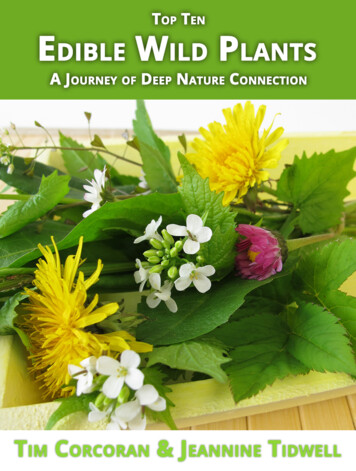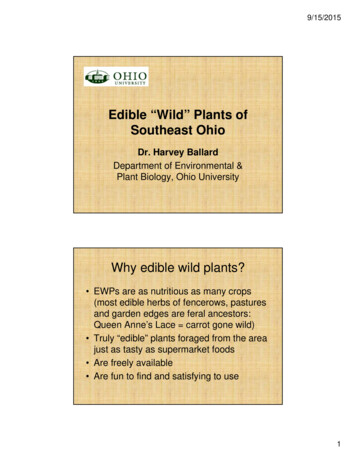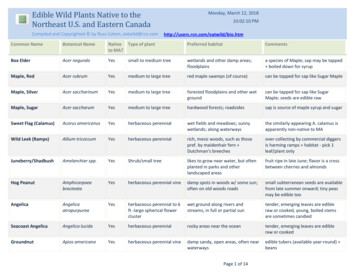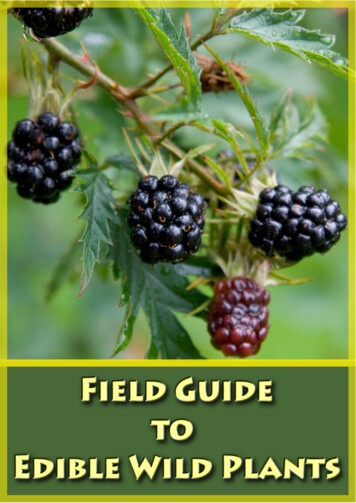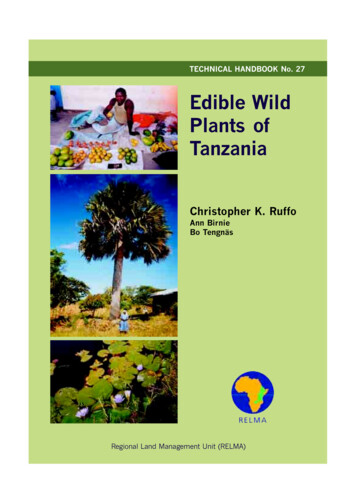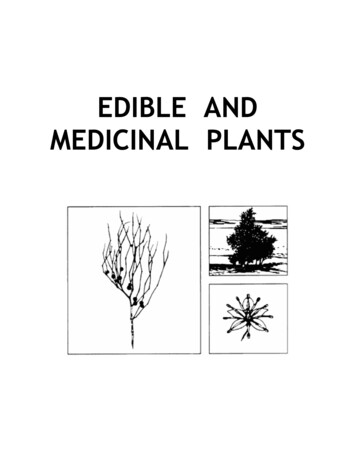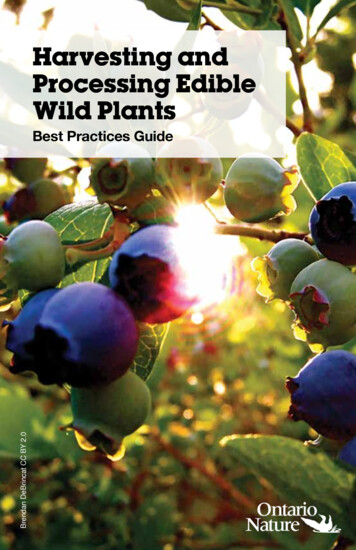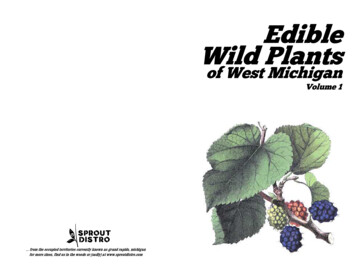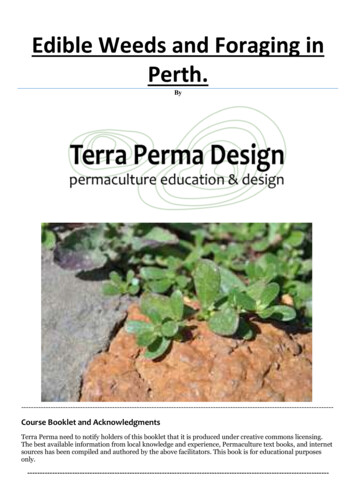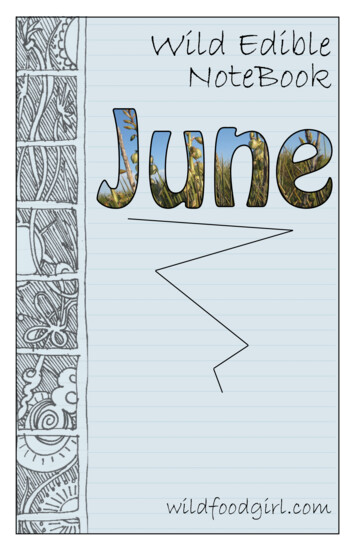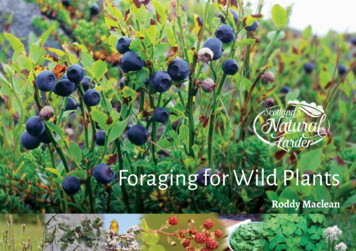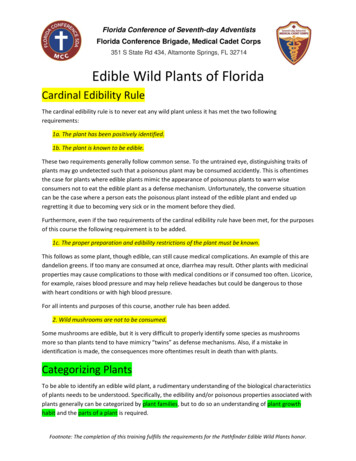
Transcription
Florida Conference of Seventh-day AdventistsFlorida Conference Brigade, Medical Cadet Corps351 S State Rd 434, Altamonte Springs, FL 32714Edible Wild Plants of FloridaCardinal Edibility RuleThe cardinal edibility rule is to never eat any wild plant unless it has met the two followingrequirements:1a. The plant has been positively identified.1b. The plant is known to be edible.These two requirements generally follow common sense. To the untrained eye, distinguishing traits ofplants may go undetected such that a poisonous plant may be consumed accidently. This is oftentimesthe case for plants where edible plants mimic the appearance of poisonous plants to warn wiseconsumers not to eat the edible plant as a defense mechanism. Unfortunately, the converse situationcan be the case where a person eats the poisonous plant instead of the edible plant and ended upregretting it due to becoming very sick or in the moment before they died.Furthermore, even if the two requirements of the cardinal edibility rule have been met, for the purposesof this course the following requirement is to be added.1c. The proper preparation and edibility restrictions of the plant must be known.This follows as some plant, though edible, can still cause medical complications. An example of this aredandelion greens. If too many are consumed at once, diarrhea may result. Other plants with medicinalproperties may cause complications to those with medical conditions or if consumed too often. Licorice,for example, raises blood pressure and may help relieve headaches but could be dangerous to thosewith heart conditions or with high blood pressure.For all intents and purposes of this course, another rule has been added.2. Wild mushrooms are not to be consumed.Some mushrooms are edible, but it is very difficult to properly identify some species as mushroomsmore so than plants tend to have mimicry “twins” as defense mechanisms. Also, if a mistake inidentification is made, the consequences more oftentimes result in death than with plants.Categorizing PlantsTo be able to identify an edible wild plant, a rudimentary understanding of the biological characteristicsof plants needs to be understood. Specifically, the edibility and/or poisonous properties associated withplants generally can be categorized by plant families, but to do so an understanding of plant growthhabit and the parts of a plant is required.Footnote: The completion of this training fulfills the requirements for the Pathfinder Edible Wild Plants honor.
Parts of a PlantAs this is not a formal biology class, the rigorous study ofanatomy and physiology of plants or an introduction tobotany is not going to be covered here. However, a goodplace to start is the study of a familiar plant: a dandelion.A dandelion is composed of the following parts: theflower, the stem, the greens (aka the leaves), and theroots. The flower itself could be considered to be the mostcomplex part of the plant as it changes the most withtime; it starts out as a bud, and then the bud opens into aflower, and then after pollination the flower turns into aseed head. Furthermore, while the dandelion flower itselfhas the stamen/pistols (the pollen producing/receivingparts), the petals (the colorful part), the sepals (the greenthings that can look like petals at the back of the flower),and the heart/base of the flower (aka the receptacle justunder where the stamen/pistols connect to). In addition,the pollen (the “dust” on the ends of the stamen) and thesap (plant “blood”) sometimes play a role as well.The reason for this crash course on the parts of edible wild plants is because not all parts of edible wildplants are necessarily edible. A classic example of this would be the tomato, as the fruit is edible but allthe other parts of the plant are poisonous. Another consideration on this note is the age of the plant.For example, dandelions are entirely edible though it is recommended to eat them when they areyounger (before blooms/early blooms) as they are not supposed to be as bitter.Plant Growth Habit GroupingsMany field guides for identifying edible wild plants group the plants by plant growth habit groupings.Just like reptiles, amphibians, rodents, fish, birds, and etc. are separated in the animal world, plants canbe separated by their general characteristics and then further described by narrowing down thespecifics.Trees, Shrubs, and PalmsTrees are largely defined by height and having a singulartrunk (instead of a stem) that splits off into branches. Treesare often further narrowed down into if they areconiferous/evergreens/needle leaf or deciduous/broad leafcategories.
Shrubs can easily be distinguished from trees as shrubs tend to havemultiple trunks and typically are shorter and more bush-like. However,some trees can also be categorized off of shrubs depending on howthey were trained to grow, such as the case with the Crepe MyrtleTree.Palms happen to be completely separate from othertrees for several reasons. Two morphologicaldifferences include palms do not form annual growthrings and palms have a fibrous root systemcharacteristically (palms aremonocotyledons/monocots while trees aredicotyledons/dicots. For this reason, thecategorization offered here separates out palms as aseparate category from trees or shrubs.TreesPalms
Herbs: Annuals, Biennials, and PerennialsThe smallest of the plants, such as most “weeds”are categorized based off of how long the planttends to be alive. Annual plants are defined by theirshort growth cycle which includes the seedsgerminate, grow, flower, reproduce, and die offgenerally within the same year and hence the term,annual. Perennials start off the same as annuals, butinstead of dying off every year go dormant or “sleep” through the winter season and revive thefollowing spring, and hence the root of the word is the same as persistent. Biennials (bi two andannual year) are an in between the annuals and the perennials as they stick around for a few yearsbefore they die off, in addition to another special characteristic—they tend to have bulbs.
Specialty CategoriesSome plants tend to be so unique that they are categorized off of a defining characteristic. Aquaticplants grow in water. Vines climb onto the environment in which they grow and need another supportstructure to define their shape (like trees, chain link fences, etc.). Cacti and succulents are known forhaving very plump stems/foliage due to their ability to store water and can have spines (modifiedleaves). Other categories besides these do exist (air plants, lichens, mosses, liverworts, “fungi”, and etc.)but for the purposes of this class, edible wild plants are not identified from other groups.Plant FamiliesBeyond just plant growth habit groupings, scientists have specified plant identification characteristicseven further to group things into families. With some experience, learning plant families help withidentification as many families are consistently edible or consistently poisonous. However, some familiesin particular have both edible and poisonous parts so identifying the specific species and proper part forthe family is necessary. Six plant family examples of having both edible and poisonous parts followbelow. Nightshade family (Solanaceae) - nightshade, tomato (leaves), potato (leaves) Carrot/parsley family (Apiaceae) - Water hemlock, Poison hemlock or fool's parsley Rose family (Rosaceae) (other than: Apples, Pears, Hawthorn, Blackberry, Raspberry, Rose hops,etc. fruits) - cherry (leaves, seeds, bark) Daisy family (Asteraceae/Compositae) (other than: Asters, Balsam root, Burdock, Chamomile,Chicory, Dandelion, Golden rod, Jerusalem artichoke, Oxeye daisy, Pineappleweed, Pricklylettuce, Salsify, Sow thistle, Thistle, Wild lettuce, Wild sun flower, etc.) - white snake root Legume family (Fabaceae) - Goat's rue, indigo, locust (seed pods), Lupine, Rattlebox Lily family (Liliaceae)(other than: Avalanche lily, Camas, Day lily, Desert lily, Dogtooth violet,Indian cucumber, Leek, Tiger lily, Wild garlic, Wild onion, Yellow bells, etc.) - False Hellebore, FlyPoison, Star of Bethlehem (pictured), Deathcamas
Preparation MethodsAs with any raw ingredient, there are many ways to prepare edible wild plants such that they can end upcomposing a meal. The most obvious method is to eat the edible wild plant raw, however, with someedible wild plants cooking is required to make them tasty or even edible.Some of the methods for preparing edible wild plants includes the urEdible wild plants often are versatile with multiple parts that can be prepared in different ways. Forexample, pine trees have nuts that are edible raw and can be roasted, the needles can be boiled tomake tea, and the sap can be chewed and spat out like bubblegum. Also, dandelions are very versatileas the roots, stem, greens, and the flower. Though cooked greens and fried dandelion flower frittersmay be more obvious recipes, the roots can be roasted to make a caffeine free coffee substitute (learnmore at https://youtu.be/Tqc3wsff36Q).Making FlourOf all the different preparation methods for edible wild plants, making flour is generally the mostcomplicated. Typically, flour as it is known is made from grains, such as wheat or rice flour, but it canalso be made from nuts (coconut, etc.) and roots (tapioca, etc.). This is generally a labor intensiveprocess, which may be even more so if the edible wild plant requires boiling/steeping of the flower tomake it palatable or safe to eat. An example of this would be acorns from any oak tree. Though they areedible, the flour requires boiling or steeping out the tannins which makes the flour bitter.Exercises1. Sort the Florida Edible Wild Plant flashcards into different piles for the following: Plant Growth Habit Grouping Nutrition Category (fruit, vegetable, nut, etc.) Edible Preparation Method2. Identify the edible plant from the picture.3. If available, go find, collect, prepare, and consume edible wild plants.
BibleAnswer the following questions by looking up the verses.1. What was created each day of creation and on which day were plants created? (Genesis 1-2)2. What was the original diet in the Garden of Eden? (Genesis 1:29-30, 2:15-27)3. What was the diet after the fall? How is it different from before the fall? (Genesis 3:17-19)4. What was the diet after the Flood? How is it different from before the flood? (Genesis 6:18-22; 7:1-5;8:17-20; 9:1-7)5. What are the distinguishing characteristics for clean and unclean foods?a. Leviticus 11b. Deuteronomy 146. Discuss how the following New Testament passages relate to diet and foods.a. John the Baptist’s diet (Matthew 3:4, for commentary on locusts:http://bibletools.info/Matt 3.4)b. Jesus feeding the 5,000 (Matthew 14:13-21; Mark 6:31-44; Luke 9:12-17; John 6:1-14) andFeeding the 4,000 (Matthew 15:32-39; Mark 8:1-9)c. Defiling Food (Mark 7)d. Peter’s Sheet (Acts 11, with context of the whole chapter)e. What Gentiles were to do (Acts 15:20, 29 in context of the chapter)
List of Florida Edible Wild .19.20.21.22.23.24.25.26.27.Clover/Wood sorrel - tea, green. Annual.Dandelions- tea, green. Annual.Beautyberries- fruit. Shrub.Armenian Blackberries- fruit, tea. Vine.Maypops/Passion Fruit- fruit. Vine.Gopher Apple- fruit. Shrub.Eastern Prickly pear- fruit, pads. Cactus.Persimmons- fruit. Tree.Citrus- fruit. Tree.Cabbage Palm- heart. Palm.Pickerel weed- root. Water plantFragrant Water Lily or American Water Lily- cooked young leaves, cooked flowerheads, cookedseeds. Water plant.Yellow Water Lily- cooked roots (starch), cooked young leaves, parched seeds. Water plant.Cattails- green, root. Water plant.Dollar weed- green. Annual.Acorns/Oak trees- nut flour. Tree.Pine tree- nuts. Tree.Galberry- tea. Shrub.Yaopon- tea. Shrub.Purselane- green. Annual.Coconut- nut. Palm.Coontie/Florida Arrowroot- root. starch post fermentation. Shrub.Everglades Tomato- fruit. Annual.Fox grapes- fruit. Vine.Spiderwort/Hurricane Flower- flowers, stems, leaves, sap insect bite relief. Perennial.Saw Palmetto- heart. Shrub.Betony or Florida Hedge Nettles or Wild Radish. Roots. Annual.
Edible Wild Plants Flash CardsClover/Wood sorrel - tea, green. Annual.Dandelions- tea, green. Annual.More detail found on Amazing Discoveries’ video. https://youtu.be/Tqc3wsff36QBeautyberries- fruit. Shrub.
Armenian Blackberries- fruit, tea. Vine.Maypops/Passion Fruit- fruit. Vine.Gopher Apple- fruit. Shrub.
Eastern Prickly pear- fruit, pads. Cactus.Persimmons- fruit. Tree.Citrus- fruit. Tree.
Cabbage Palm- heart. Palm. “swamp cabbage”(smooth stem)Pickerel weed- root. Water plantFragrant Water Lily or American Water Lily- cooked young leaves, cooked flowerheads, cooked seeds.Water plant.
Yellow Pond Lily- cooked roots (starch), cooked young leaves, cooked seeds. Water plant.Cattails- green, root. Water plant.Dollar weed- green. Annual.
Acorns/Oak trees- nut flour. Tree.Pine tree- nuts. Tree.stone pine treeGallberry- tea. Shrub.
Yaopon- tea. Shrub.Purselane- green. Annual.Coconut- nut. Palm.
Coontie/Florida Arrowroot- root. starch post fermentation. Palm Shrub.Everglades Tomato- fruit. Annual.Fox Grapes or Wild Muscadine Grapes- fruit. Vine.
Spiderwort/Hurricane Flower- flowers, stems, leaves, sap insect bite relief. Perennial.Saw Palmetto- heart. Palm like Shrub.(saw-tooth spines along stem)Betony or Florida Hedge Nettles or Wild Radish. Roots. Annual.
Edible Wild Plants of FloridaFor course certification, the form must be filled out.Member Name (Print)Instructor Name (Print)Member Position NumberInstructor Position NumberMember FEMA SIDInstructor FEMA SIDDate of InstructionDefine the Cardinal Edibility Rule and edibility rules for this course.Be able to identify:Parts of a PlantPlant Growth Habit GroupingsPlant Families with both poisonous and edible partsDefine the various preparation methods for edible wild plants.Complete the Exercises.Be able to give a Bible study on plants and diet.With a complete sheet of initials, the instructor’s signature signifies certification of completion for theEdible Wild Plants of Florida course.Instructor Signature
edible wild plants cooking is required to make them tasty or even edible. Some of the methods for preparing edible wild plants includes the following: a. Boiling b. Roasting c. Frying d. Baking e. Flour Edible wild plants often are versatile with multiple parts that can be prepared in diffe
